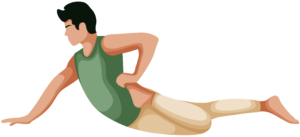Half Frog (Ardha Bhekasana)
Pose Overview
| Common Name | Half Frog |
| Traditional Sanskrit Name | Ardha Bhekasana |
| Sanskrit Name Pronunciation | are-dah beh-kay-sah-nah |
| Pose Difficulty | Intermediate |
| Drishti
Drishti is the gaze or visual focus point during yoga poses.
Learn more about Drishti |
Upward, towards the sky |
Half Frog Pose, also known as Ardha Bhekasana, is an intermediate yoga pose that provides a great way to strengthen the core and glutes. The pose gets its name from its resemblance to a frog, with the body in a half-squat position and the arms reaching forward. It is a variation of the full Frog Pose, which is a deeper, more advanced version of the pose.
Benefits of Half Frog
Half Frog Pose is an excellent pose for building strength and stability in the core, glutes, and thighs. It also helps to improve balance and stability, and can be therapeutic for those with knee pain.
How to Enter Half Frog
Start in a low lunge position with your left leg forward. Bring your hands to the floor on either side of your left foot. Slowly lower your left knee to the floor and slide your left foot towards your left hand. Slowly lower your hips towards the floor and bring your hands to the front of your left foot. Keep your left knee and foot in line with your hip and press your left foot into your hands to lift your chest and lift your gaze forward.
How to Exit Half Frog
Slowly release your hands from your foot and straighten your left leg. Rise up to a low lunge position and repeat on the other side.
Common Half Frog Modifications & Variations
To make the pose easier, place a blanket or block under your left knee for support. To make the pose more challenging, lift the back leg off the floor and balance on the front leg.
Common Mistakes with Half Frog
Not keeping the knee and foot in line with the hip, which can cause strain on the knee. Not engaging the core and glutes, which can cause the pose to be less effective.
Safety Guidance
This pose is not recommended for those with knee or ankle injuries. Make sure to keep the knee and foot in line with the hip to avoid strain on the knee.

